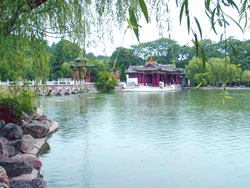The Huaqing Hot Springs is located about 35 kilometers east of the city of Xi'an.
Historically, during the Western Zhou Dynasty the construction of the Li Palace was undertaken
on this spot. In the Qin Dynasty, a stone pool was built and
 was given the name Lishan Hot Springs. The site was enlarged into a bigger palace during the Han Dynasty,
and was renamed, the Li Palace. During the Tang Dynasty, Emperor Taizong ordered the construction of
the Hot Springs Palace. Emperor Xuanzong had a walled palace built around the Lishan Mountain in
the year 747. It was known as the Huaqing Palace. It also had the name Huaqing Hot Springs because of
its location over the hot springs. Huaqing Hot Springs is located at the foot of the Lishan Mountain, a branch of the Qinling Range. Standing 1,256 meters high, it is covered with pines and cypress and looks very much like a dark green galloping horse from a long distance away. In ancient times, a black horse was called "Li", and this is how it got its name, Lishan.
was given the name Lishan Hot Springs. The site was enlarged into a bigger palace during the Han Dynasty,
and was renamed, the Li Palace. During the Tang Dynasty, Emperor Taizong ordered the construction of
the Hot Springs Palace. Emperor Xuanzong had a walled palace built around the Lishan Mountain in
the year 747. It was known as the Huaqing Palace. It also had the name Huaqing Hot Springs because of
its location over the hot springs. Huaqing Hot Springs is located at the foot of the Lishan Mountain, a branch of the Qinling Range. Standing 1,256 meters high, it is covered with pines and cypress and looks very much like a dark green galloping horse from a long distance away. In ancient times, a black horse was called "Li", and this is how it got its name, Lishan.
The Tang Emperor, Xuanzong used to spend his wintertime in company
with his favorite concubine Yang here. Yang, who was recognized
as one of the most enchanting ladies in ancient China, was spoiled
by the Emperor. He cavorted with the beautiful lady all day and
night and didn't deal with the state affair anymore. He built
the luxurious palaces in this area for their personal pleasure
and didn't deal the state affair anymore. Emperor Xuanzong's misbehavior
finally resulted in the An Lushan Rebellion which deteriorated
his regime and destroyed some of the palaces built in this site.
The present-day site is only a small part of the Tang Huaqing Palace. The Huaqing Hot Springs which
we see today was rebuilt on the site of the Qing Dynasty structure. The palace covers an area
of 85,560 square meters. Entering the West Gate of Huaqing Hot Springs, you will see the Nine-Dragon
Pool, the Lotus Flower Pool and the Frost Drifting Hall, etc. All these structures were rebuilt
in 1959 according to Tang architectural style. |